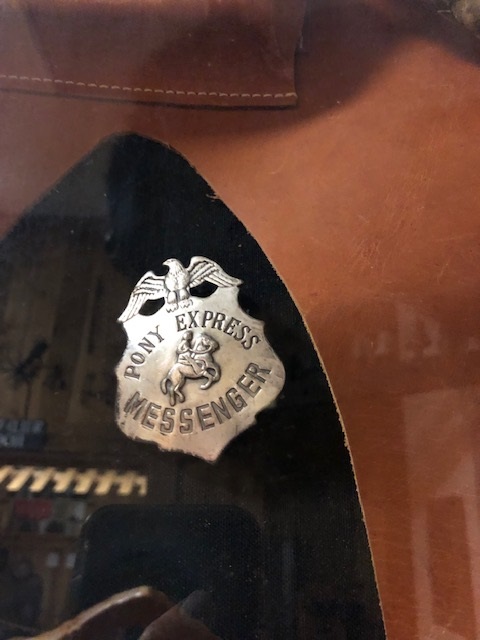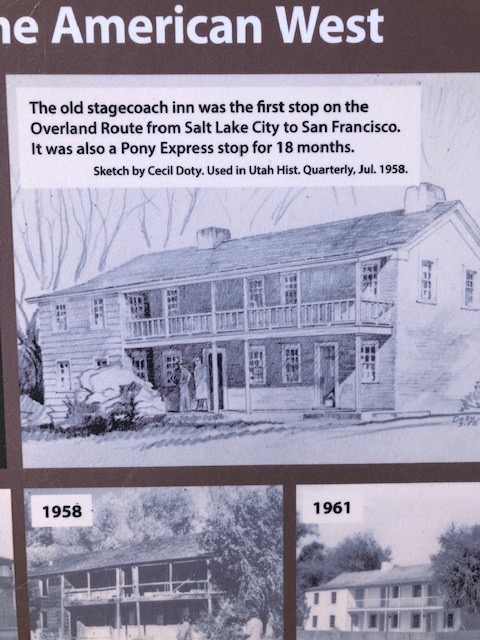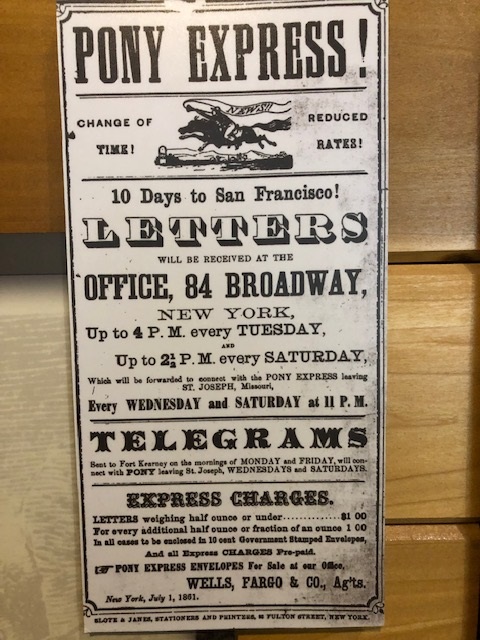
Camp Floyd State Park Museum
Image Courtesy & Copyright Mary Heers
 Images of the Old Stagecoach Inn
Images of the Old Stagecoach Inn
As Sketched by Cecil Doty and Published in the Utah Historical Quarterly July 1958 and other images therein credited.
Camp Floyd State Park Museum
Image Courtesy & Copyright Mary Heers
 Pony Express Ad
Pony Express Ad
Camp Floyd State Park Museum
Image Courtesy & Copyright Mary HeersLast month, Tom Williams’ interview with author Will Grant really caught my attention. Will was describing his adventures retracing the original Pony Express route thru Utah with his two horses, Chicken Fry and Badger. When he was crossing Utah’s West Desert, he ran into a wild stallion. The Onaqui herd of wild horses now roams freely there, but this stallion was a loner.
Will saw the horse first, about a mile away, rolling in the mud at a watering hole. Will knew the stallion would resent an intrusion into his space. Will picked up some stones.
The stallion came at them at a dead run. At the last moment, the stallion veered off and circled them at a gallop. At 40 feet Will threw his first stone. He missed. The second stone hit the stallion, who reared up and hammered the air with his front hooves. Luckily, after a few more stones the stallion had had enough and went off to graze.
Hoping to see the wild horses -from the safety of my car – I picked up the Pony Express trail as it skirted the southern edge of the Great Salt Lake. I stopped in Fairfield at a historic inn that had been the first overnight stop for the stagecoach leaving Salt Lake with the mail for the new state of California. The stagecoach journey took 25 days. The Pony Express said it could do it in 10. So, at this inn, the Pony Express rider just jumped on a waiting horse and kept going.
I wasn’t in a hurry, so I poked my head into a small brick building adjacent to the inn. Inside was a lone state park employee who was delighted to see me and insisted I watch a 10 minute video. I was amazed to find out that at this very spot over 3,000 US soldiers spent three years at what they called Camp Floyd. Then, when the Civil War broke out, the soldiers pulled up stakes and disappeared with hardly leaving a trace.
Back in my car, I followed the original pony express route for miles down an empty slim road. Up head I knew it would become so dry and desolate that water would have to be hauled to the relay stations by wagons. I was just starting to offer up a small prayer that I wouldn’t have any car trouble, when I caught sight of the highway intersecting the trail up ahead. I don’t remember ever being so happy to see traffic.
The very first Pony Express rider galloped into Utah in April 1860. Every rider rode between 75-100 miles, switching horses every 10 miles. It was expensive but it was fast. At the same time, another company, the Intercontinental Telegraph, was cutting down trees across the Utah Territory and extending their line of telegraph poles. In Oct 1861, five months after the Civil War started, the telegraph company had its 27,500 poles and 2,000 miles of iron wire in place. A message was tapped out in California, went zinging through the wires in Salt Lake, and was delivered to Abraham Lincoln’s desk. The people of California, the message read, would remain loyal to the union.
The message traveled from coast to coast in seconds. The Pony Express closed down its operations two days later. It had lasted 18 months.
This is Mary Heers and I’m Wild About Utah
Credits:
Photos: Courtesy Mary Heers, as taken at the Camp Floyd State Park Museum, Fairfield, UT
Featured Audio: Courtesy & Copyright © Friend Weller, Utah Public Radio upr.org
Text: Mary Heers, https://cca.usu.edu/files/awards/art-and-mary-heers-citation.pdf
Additional Reading: Lyle Bingham, https://bridgerlandaudubon.org/
Additional Reading
Wild About Utah, Mary Heers’ Wild About Utah Postings
2021 Onaqui Mountain Wild Horses Gather, Bureau of Land Management, US Department of the Interior, July 18, 2021, https://www.blm.gov/programs/whb/utah/2021-onaqui-wild-horse
Onaqui Mountain HMA, Bureau of Land Management, US Department of the Interior, https://www.blm.gov/programs/wild-horse-and-burro/herd-management/herd-management-areas/utah/onaqui-mountain
Grant, Will, The Last Ride of the Pony Express: My 2,000-mile Horseback Journey into the Old West, Little, Brown and Company, June 6, 2023, https://www.amazon.com/Last-Ride-Pony-Express-Horseback/dp/0316422312
“The horse went extinct in the Americas (along with other large mammals like the mammoth and giant sloth) about 10,000 years ago. It was the Spanish Conquistadors that reintroduced the horse to North America. When Hernan Cortez and his 200 soldiers landed in Mexico in 1519, they brought 16 horses with them. Over time, some of these horses got away to form wild bands, and others fell into the hands of the Native Americans.”
Heers, Mary, Gallop Thru Time, Wild About Utah, August 22, 2022, https://wildaboututah.org/gallop-thru-time/
